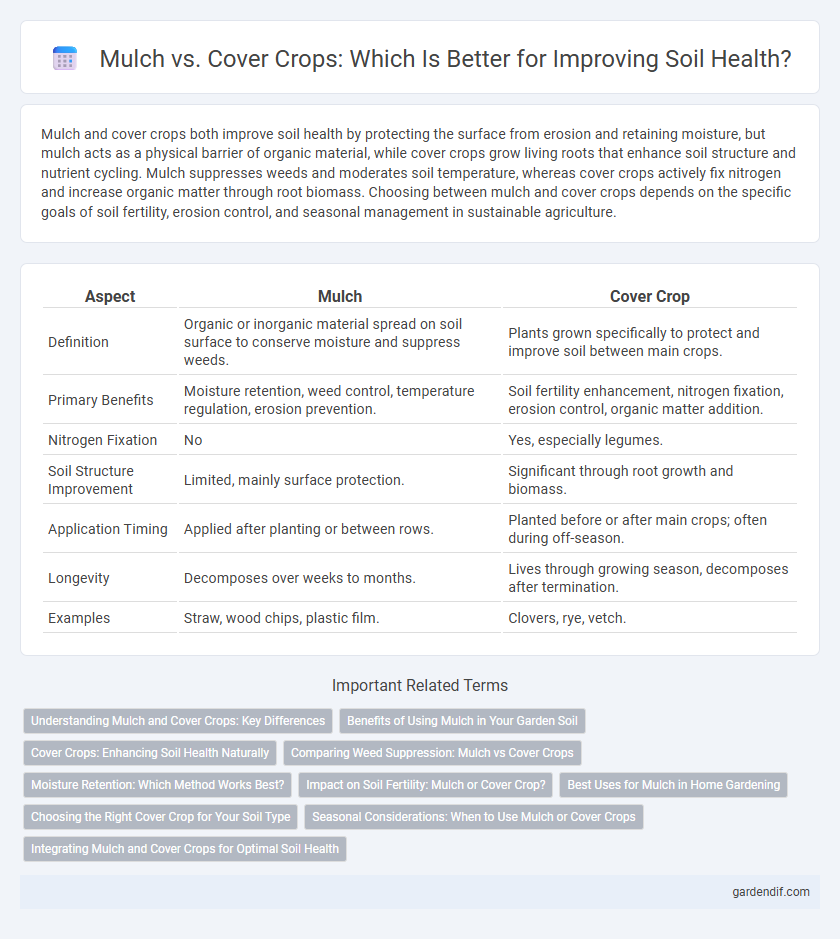
Mulch vs Cover crop Illustration
Mulch and cover crops both improve soil health by protecting the surface from erosion and retaining moisture, but mulch acts as a physical barrier of organic material, while cover crops grow living roots that enhance soil structure and nutrient cycling. Mulch suppresses weeds and moderates soil temperature, whereas cover crops actively fix nitrogen and increase organic matter through root biomass. Choosing between mulch and cover crops depends on the specific goals of soil fertility, erosion control, and seasonal management in sustainable agriculture.
Table of Comparison
| Aspect | Mulch | Cover Crop |
|---|---|---|
| Definition | Organic or inorganic material spread on soil surface to conserve moisture and suppress weeds. | Plants grown specifically to protect and improve soil between main crops. |
| Primary Benefits | Moisture retention, weed control, temperature regulation, erosion prevention. | Soil fertility enhancement, nitrogen fixation, erosion control, organic matter addition. |
| Nitrogen Fixation | No | Yes, especially legumes. |
| Soil Structure Improvement | Limited, mainly surface protection. | Significant through root growth and biomass. |
| Application Timing | Applied after planting or between rows. | Planted before or after main crops; often during off-season. |
| Longevity | Decomposes over weeks to months. | Lives through growing season, decomposes after termination. |
| Examples | Straw, wood chips, plastic film. | Clovers, rye, vetch. |
Understanding Mulch and Cover Crops: Key Differences
Mulch consists of organic or inorganic materials spread on the soil surface to conserve moisture, regulate temperature, and suppress weeds, while cover crops are planted specifically to improve soil health by enhancing nutrient content, preventing erosion, and increasing biodiversity. Mulch primarily acts as a protective layer, whereas cover crops actively contribute to soil structure and fertility through root growth and biomass incorporation. Selecting between mulch and cover crops depends on targeted outcomes such as moisture retention or soil enrichment in sustainable agricultural practices.
Benefits of Using Mulch in Your Garden Soil
Mulch improves soil moisture retention by reducing evaporation, which is essential for healthy plant growth and water conservation. It also suppresses weed growth, minimizing competition for nutrients and reducing the need for chemical herbicides. Furthermore, organic mulch gradually decomposes, enriching garden soil with vital nutrients and enhancing soil structure.
Cover Crops: Enhancing Soil Health Naturally
Cover crops improve soil health by increasing organic matter, enhancing nutrient cycling, and preventing erosion. They support beneficial microbial activity and improve soil structure, which boosts water retention and root growth. Cover crops like clover, rye, and vetch fix nitrogen naturally, reducing the need for synthetic fertilizers.
Comparing Weed Suppression: Mulch vs Cover Crops
Mulch effectively suppresses weeds by creating a physical barrier that blocks sunlight, preventing weed seed germination and growth. Cover crops not only inhibit weeds through shading and competition for nutrients but also enhance soil health by adding organic matter and improving structure. Comparatively, mulch provides immediate weed control, while cover crops offer long-term soil benefits alongside gradual weed suppression.
Moisture Retention: Which Method Works Best?
Mulch creates a protective barrier on the soil surface, significantly reducing evaporation and maintaining consistent moisture levels. Cover crops improve soil structure and organic matter, enhancing water infiltration and retention over time. For immediate moisture retention, mulch is more effective, while cover crops provide long-term moisture benefits through improved soil health.
Impact on Soil Fertility: Mulch or Cover Crop?
Mulch improves soil fertility by conserving moisture, regulating temperature, and gradually adding organic matter as it decomposes, which enhances microbial activity. Cover crops actively boost soil fertility by fixing nitrogen, increasing organic matter, and preventing nutrient loss through erosion control. Both methods contribute to soil health, but cover crops provide more direct nutrient input and long-term soil structure benefits.
Best Uses for Mulch in Home Gardening
Mulch in home gardening excels at moisture retention, temperature regulation, and weed suppression, creating optimal conditions for plant growth. Organic mulches such as wood chips, straw, and shredded leaves decompose slowly, enriching soil fertility over time. Applying mulch around vegetables, flowers, and shrubs improves soil structure and supports beneficial microbial activity.
Choosing the Right Cover Crop for Your Soil Type
Selecting the ideal cover crop depends on soil texture, pH, and nutrient levels, with legumes like clover thriving in nitrogen-poor soils and grasses such as rye benefiting compacted clay soils. Mulch provides immediate organic matter and moisture retention, but cover crops enhance soil structure, prevent erosion, and fix nitrogen over time. Understanding your soil's specific characteristics allows for optimized cover crop selection, improving soil fertility and crop yields sustainably.
Seasonal Considerations: When to Use Mulch or Cover Crops
Mulch is most effective during dormant or dry seasons, providing soil moisture retention and temperature regulation, while cover crops thrive in growing seasons by enhancing soil fertility and structure through nitrogen fixation and biomass addition. Choosing between mulch and cover crops depends on crop rotation timing, local climate, and specific field conditions, as cover crops require active growth periods for optimal nutrient cycling. Seasonal application of mulch after harvest can protect soil from erosion and suppress weeds, whereas cover crops are best planted before or after main crops to prepare soil for the next planting cycle.
Integrating Mulch and Cover Crops for Optimal Soil Health
Integrating mulch and cover crops enhances soil health by improving moisture retention and increasing organic matter, which supports beneficial microbial activity. Mulch acts as a protective layer, reducing erosion and temperature fluctuations, while cover crops fix nitrogen and prevent nutrient leaching. Combining these practices leads to improved soil structure, fertility, and long-term sustainability in agricultural systems.
Mulch vs Cover crop Infographic

 gardendif.com
gardendif.com